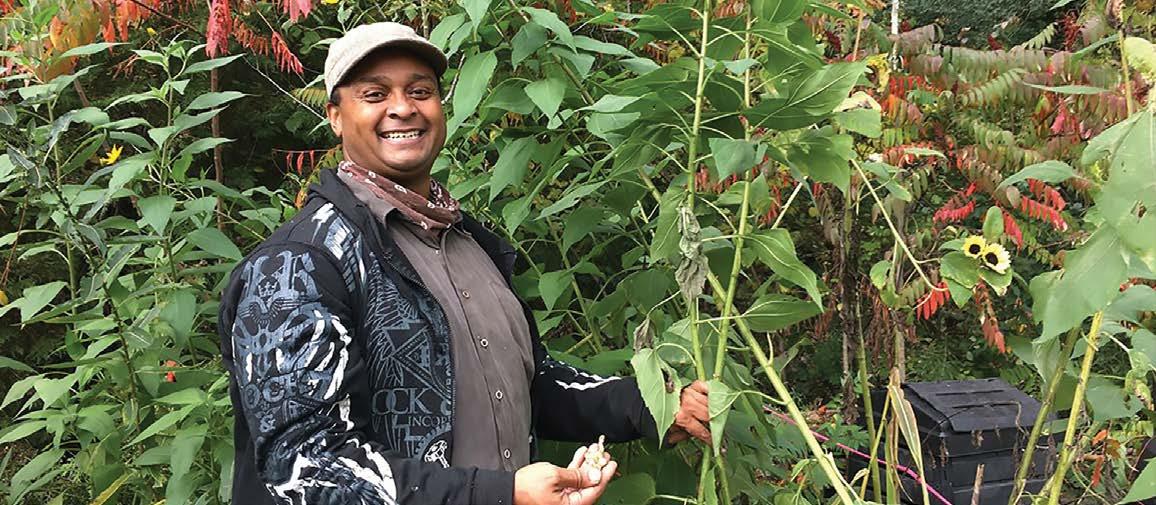
6 minute read
Coming soon: EV charging for homes and businesses
Transport: it’s electrifying
Green energy is an essential part of any sustainability strategy, but it’s not the only area we need to focus on. The transport sector is responsible for about a quarter of all Canadian emissions1, and electrifying our fleets and personal vehicles is a must if we’re going to meet the climate goals set out in the Paris Agreement.
Advertisement
The question is no longer if electric vehicles (EVs) will catch on, it’s how quickly they’ll take over. Automakers around the world are announcing electric models, and the Government of Canada has set a mandatory target for all new light-duty cars and passenger trucks to be zero-emission by 2035. Drivers are also getting on board, with annual passenger EV sales expected to reach 14 million in 2025, compared to 3 million in 2020.2
“To remain successful, we need profitable growth. So instead of investing in a shrinking business, we choose to invest in the future – electric and online. We are fully focused on becoming a leader in the fastgrowing premium electric segment.” - Håkan Samuelsson, CEO, Volvo Cars
EVs are coming fast, and we’ll need a robust, reliable, and low-carbon charging network to keep them running. That’s why we’re excited to launch an electric vehicle charging solution in 2022. Our parent company, Spark Power, is already a leader in EV infrastructure, and we can’t wait to offer our combined expertise to new and existing Bullfrog customers.
Since 2017, Spark has built EV charging sites from B.C. to Nova Scotia. We’ve installed 25 MW of total charging capacity, and we’re ready to install and service electric vehicle supply equipment (EVSE). We’re currently working for IVY Charging Network to build twelve charging sites at ONroute plazas along Ontario’s Highway 401.
So what does this mean for Bullfrog? We’re working on a seamless EV charging solution for homes and small businesses. Once you’re ready to go electric, we’ll take care of everything you need to stay charged. And if you’re already bullfrogpowered, you’ll have the added benefit of knowing that your vehicle’s energy footprint is 100% emissions-free.
Interested in learning more? Visit bullfrogpower.com/ev to sign up for email updates about this product.
¹ Environment and Climate Change Canada 2 BloombergNEF ³ Forbes, Car and Driver
When will automakers phase out internal combustion engines?3
Audi: 2033 BMW: no commitment Bentley: 2030 Fiat/Chrysler: no commitment Ford: 2030 (Europe only) GM: 2035 Honda: 2040 Hyundai: no commitment Jaguar/Land Rover: 2036 Mazda: no commitment Mercedes-Benz: 2030 (with some caveats) Mitsubishi: no commitment Nissan: no commitment Toyota: no commitment Volvo: 2030 VW: 2035 (Europe only)

Sustainable gardening with Isaac Crosby
Isaac Crosby, Lead in Urban Agriculture at Evergreen, is also known as Brother Nature. He comes from a small farming community south of Windsor and went on to study Landscape Horticulture Tech at Humber College. Isaac is proud of his Ojibwa and Black Canadian heritage, and he incorporates his education and traditional First Nations knowledge to grow great crops, to teach others, and to do his part in saving the Earth.
“We must work with nature and not against her. By concentrating on a more holistic approach to gardening [...] we can have successful gardens that will stand the test of time.” - Isaac Crosby, Lead in Urban Agriculture, Evergreen
Brother Nature hosted a sustainable gardening webinar for the bullfrogpowered community. In case you missed it, we’ve included his recipes for homemade bug spray and fertilizer — try them in your garden or on your neglected office plants. To learn more about urban agriculture and the work Evergreen is doing to create cities that are livable, green and prosperous, sign up for their newsletter at evergreen.ca/newsletter
Homemade bug spray
• 1 litre water • 5 drops of Dawn dish soap • 1/2 cup of 70% rubbing alcohol
Mix together and spray over the entire plant, including surrounding soil.
Homemade fertilizer
• 1 tablespoon baking soda • 1 tablespoon Epsom salts • 1 teaspoon household ammonia (do not use industrial ammonia) • 3.65 litres (1 gallon) of water
Mix together and apply to plants and soil once a month.


Class of 2021 Class of 2021
net zero by 2050
Young people are a powerful force in the climate movement, and Youth Challenge International (YCI) is helping them turn their ideas into action. YCI’s Youth Climate Leadership Program gives young people from the Greater Toronto and Hamilton Area comprehensive training on designing and growing a sustainable project, mobilizing youth, and encouraging community development while deepening their understanding of climate science and traditional ecological knowledge.
On behalf of the bullfrogpowered community, we’re proud to support the Youth Climate Leadership Program’s pitch night prizes. These funds will help youth launch and grow their climate action ideas. Meet some of the pitch night participants below, and head to $2,500 pitch night winner!!! youthclimateaction.ca to learn more.



Angelina La Ashwini Selvakumaran Purvangi Patel
Angelina created Food Unity to engage, empower, and employ youth in under-served communities to increase food access. She’s working on a meal subscription pilot where youth will use rescued food to prepare healthy, culturally appropriate meals for families in Black Creek.
Ashwini created the Brown Citizen Circle (BCC) to elevate the voices of Black, Indigenous, and South Asian youth that have been marginalized in climate advocacy throughout the GTA. In August, the BCC hosted it’s first BIPOC Youth Social Policy Case Competition to combat climate stigmatization.
Purvangi created Change for Transit (C4T) to address the growing gaps between public transport infrastructure and the community in cities across the GTHA. C4T is rethinking the culture that surrounds mobility and public infrastructure while empowering youth to develop creative solutions.

Saumya Suresh
Saumya created Halton Composts to spread awareness about plasticfree food packaging. Particularly during COVID-19, restaurants have been relying more on takeout, leading to more plastic food packaging waste. Halton Composts is providing restaurants with the information they need to switch to compostable alternatives.

Charlotte Dunford-Dionne
Charlotte created Second Life Patterns Co. as a solution to combat textile waste. As home sewing continues to grow in popularity, Charlotte wants to create a collection of home sewing patterns that are designed to use pre-loved textiles rather than new fabric.
Umair Ghantiwala

Umair is further developing the New Grocery Movement, a nascent nonprofit dedicated to dismantling the harmful structures that perpetuate food insecurity, intensive commercial agriculture, and environmental degradation. Umair aims to build a consumer-driven movement to demand better food and access for everyone.
Megan Halferty

Megan created Green Urban Revitalization (GreenUR) to provide experiential education on waste management through the topics of fast fashion and consumerism. Seeing a gap in Ontario’s curriculum, Megan’s goal is to engage high school students in workshops and activities where they can act as global citizens.

Marlene Rong
Marlene created Green Committee Connect (GCC), a platform that provides resources to green committees across Toronto and creates a space for them to connect and collaborate. Through their website, GCC is supporting tenant-led zero waste initiatives in multi-residential buildings.
Rachel Davis

Rachel founded Desire Paths to develop an interactive digital activity for Toronto high school students to visualize the achievable future of a “habitable Earth.” She noticed that youth became discouraged when they couldn’t live up to an ideal sustainable lifestyle, so her project aims to turn feelings of climate guilt into empowerment.



